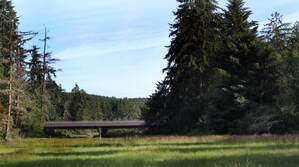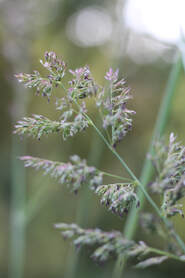Pore Water Sampling at Stillwaters
Hydric and Hydrologic Conditions for Salt Marsh Vegetation
A companion monitoring effort to our vegetation survey is a pore-water survey in the same vegetation plots. Pore water is the water than can be extracted from the soil at root depth, specifically from between the soil particles. It is a sample of the water that the plants are growing in at a given time, and an observer may be surprised at how clear the water sample appears upon extraction. The idea is to measure salinity, pH, and other water quality attributes to determine how much salt water vs. fresh water the plants are experiencing during different phases of their growth cycle.

Plants that can be salt-tolerant as adults are often less tolerant at younger stages of life. Such plants may have benefitted from the fresh water backed up behind the culvert during heavy rains early in the growing season, possibly at the expense of typical native salt-marsh plants.
Taking pore water samples at different points during the plants’ life cycle (emergence, peak growth, and maturity) will allow us to better understand why some plants may be thriving in certain plots but not others. Last summer’s samples taken in and just outside areas with reed canary grass revealed that pore water around the roots was less saline than pore water just outside of the patch. This suggests that tidal inundation might be limiting the spread of reed canary away from the creek banks.
Taking pore water samples at different points during the plants’ life cycle (emergence, peak growth, and maturity) will allow us to better understand why some plants may be thriving in certain plots but not others. Last summer’s samples taken in and just outside areas with reed canary grass revealed that pore water around the roots was less saline than pore water just outside of the patch. This suggests that tidal inundation might be limiting the spread of reed canary away from the creek banks.

Monitoring equipment such as water-level loggers deployed in the creek help us monitor changes in salt-water tidal inputs as well as freshwater inputs from Carpenter Creek, rainfall, and nearby seepage. The pore water collection is now more efficient with a volunteer-constructed 12-volt vacuum pump, and data collection is faster and more accurate with a new YSI water quality meter. In addition, we have also been developing a finer scale elevation map of the salt marsh so that we can determine how long different vegetation plots are inundated during high tides at different times of year.
Depending on weather, sampling may continue into the fall, allowing us to take soil cores near our vegetation plots to understand their vegetation history. This is determined by examining dead plant material build-up and the soil conditions favored by different plant communities. At the same time, we hope to install simple ground water wells to identify how water levels change with tide and rainfall and how this change affects the pore water.
Depending on weather, sampling may continue into the fall, allowing us to take soil cores near our vegetation plots to understand their vegetation history. This is determined by examining dead plant material build-up and the soil conditions favored by different plant communities. At the same time, we hope to install simple ground water wells to identify how water levels change with tide and rainfall and how this change affects the pore water.
Sampling Step-by-Step
- Check the tide before you head out into the salt marsh.
- Use mapping software to determine exact location.
- Prepare the pore water sampler - a tool that is inserted at roots' depth to create a channel for water extraction.
- Using a volunteer-constructed 12-volt vacuum pump makes the pore water collection now more efficient.
- Melissa carefully collects the water into the sample container.
- While Melissa holds the water sample, Kit uses a new YSI water quality meter that makes data collection faster and more accurate.
- Record sampling conditions.
- Don't forget to take a whiff! Just the simple act of smelling a water sample can provide key information.


